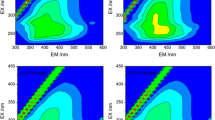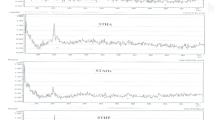Abstract
Perfluorooctane sulfonate (PFOS) is one of the most widespread toxic substances in water distribution systems, posing a significant risk to public health and the environment due to its toxic and non-biodegradable nature. In this study, the effect of oxalate on PFOS adsorption/desorption to/from soil and sediment samples was studied with batch experiments. Dissolved organic carbon content in soil strongly enhanced the retention of organic halogens. Oxalate increased PFOS desorption by 1.43- to 17.14-fold and significantly increased the release of dissolved organic carbon and inorganic ions in soils. The effects of root exudates were similar to those of oxalate. Addition of low molecular weight dissolved organic carbon caused partial dissolution of the soil structure (e.g., through formation of organo-mineral complexes), resulting in the release of organic carbon and metal ions and subsequently enhancing PFOS desorption. The effects of oxalate on organic halogen desorption were influenced by dissolved organic carbon content and formation of calcium oxalate.





Similar content being viewed by others
References
An, C. J., Huang, G. H., Wei, J., &Yu, H. (2011). Effect of short-chain organic acids on the enhanced desorption of phenanthrene by rhamnolipid biosurfactan in soil-water environment. Water Research, 45(17), 5501–5510.
Bhatti, J. S., Comerford, N. B., & Johnston, C. T. (1998a). Influence of oxalate and soil organic matter on sorption and desorption of phosphate onto a spodic horizon. Soil Science Society of America Journal, 62, 1089–1095.
Bhatti, J. S., Comerford, N. B., & Johnston, C. T. (1998b). Influence of soil organic matter removal and pH on oxalate sorption onto a spodic horizon. Soil Science Society of America Journal, 62, 152–158.
Blank, R. R., Allen, F., & Young, J. A.(1994). Extractable anions in soilsfollowing wildfire in a sagebrushgrass community. Soil Science Society of America Journal, 58(2), 564–570.
Cao, M. H., Ye, Y. Y., & Chen, J. (2016). Remediation of arsenic contaminated soil by coupling oxalate washing with subsequent ZVI/air treatment. Chemosphere, 144, 1313–1318.
Chen, H., Zhang, C., Yu, Y., & Han, J. (2012). Sorption of perfluorooctane sulfonate (PFOS) on marine sediments. Marine Pollution Bulletin, 64, 902–906.
Desilva, A. O., & Mabury, S. A. (2006). Isomer distribution of perfluorocarboxylates in human blood: potential correlation to source. Environmental Science and Technology, 40(9), 2903–2909.
Dietz, R., Bossi, R., Rigét, F. F., Sonne, C. E., & Born, W. (2008). Increasing perfluoroalkyl contaminants in east Greenland polar bears (Ursus maritimus): a new toxic threat to the Arctic bears. Environmental Science and Technology, 42, 2701–2707.
Ding, Y. Z., Li, Z., & Zou, B. (2005). Low-molecular-weight organic acids and their ecological roles in soil. The Soil, 37(3), 243–250 (in Chinese).
Du, Z. W., Deng, S. B., Bei, Y., Huang, Q., Wang, B., & Huang, J. &Yu, G. (2014). Adsorption behavior and mechanism of perfluorinated compounds on various adsorbents—a review. Journal of Hazardous materials., 274, 443–454.
Ericson, I. J., Gemma, P., Xavier, L., Esther, B., Roser, M. C., Anna, K., & José, L. D. (2009). Exposure to perfluorinated compounds in Catalonia, Spain, through consumption of various raw and cooked foodstuffs, including packaged food. Food and Chemical Toxicology, 47, 1577–1583.
Frommea, H., Sheryl, A. T., Wolfgang, V., Michael, W., & Dorothee, T. (2009). Perfluorinated compounds—exposure assessment for the general population in western countries. International Journal of Hygiene and Environmental Health, 212, 239–270.
Gao, Y. X., Deng, S. B., Du, Z. W., Liu, K., & Yu, G. (2017). Adsorptive removal of emerging polyfluoroalky substances F-53B and PFOS by anion-exchange resin: A comparative study. Journal of Hazardous Materials, 323, 550–557.
Giesy, J. P., & Kannan, K. (2002). Perfluorochemical surfactants in the environment. Environmental Science and Technology, 36, 146A–152A.
Gunawardana, B., Singhal, N., & Johnson, A. (2010). Amendments and their combined apolyoropyleel cation for enhanced copolyoropyleneer, cadmium, lead uptake by Lolium perenne. Plant and Soil, 329(12), 283–294.
Ingrid, E., Martí, N., Bert, V. B., Gunilla, L., & José, L. D. (2008). Levels of perfluoro chemicals in water samples from Catalonia, Spain: is drinking water a significant contribution to human exposure. Environmental Science and Pollution Research International, 15, 614–619.
Jeon, J., Kannan, K., Lim, B. J., An, K. G., & Kim, S. D. (2011). Effects of salinity and organic matter on the partitioning of perfluoroalkyl acid (PFAs) to clay particles. Journal of Environmental Monitoring, 13, 1803–1810.
Johnson, R. L., Anschutz, A. J., Smolen, J. M., Simcik, M. F., & Penn, R. L. (2007). The adsorption of perfluorooctane sulfonate onto sand, clay, and iron oxide surfaces. Journal of Chemical and Engineering Data, 52, 1165–1170.
Jones, D. L., & Brassington, D. S. (1998). Sorption of organic acids in acid soils and its implications in the rhizosphere. European Journal of Soil Science, 49(3), 447–455.
Kallenborn, R., Berger, U., & Jarnberg, U. (2004). Perfluorinated alkylated substances (PFAS) in the Nordic environment. Organohalogen Compounds, 66, 4046–4052.
Key, B. D., Howell, R. D., & Criddle, C. S. (1997). Fluorinated organics in the biosphere. Environmental Science and Technology, 31, 2445–2454.
Lu, Y. F., & Pignatello, J. J. (2004). Sorption of apolar aromatic compounds to soil humic acid particles affected by aluminum (iii) ion cross-linking. Journal of Environmental Quality, 33, 1314–1321.
Luo, L., Zhang, S. Z., Shan, X. Q., & Zhu, Y. G. (2006). Oxalate and root exudates enhance the desorption of p,p′-DDT from soils. Chemosphere, 63, 1273–1279.
Manning, B. A., & Goldberg, S. (1997). Arsenic(III) and arsenate(V) adsorption on three California soils. Soil Science, 162, 886–895.
Milinovic, J., Lacorte, S., Vidal, M., & Rigol, A. (2015). Sorption behaviour of perfluoroalkyl substances in soils. Science of the Total Environment, 511, 63–71.
OECD. (2000). OECD guideline for the testing of chemicals: adsorption–desorption using a batch equilibrium method. Organization for Economic Co-operation and Development (OECD/OCDE 106).
Ololade, I. A., Zhou, Q., & Pan, G. (2016). Influence of oxic/anoxic condition on sorption behavior of PFOS in sediment. Chemosphere, 150, 798–803.
Pan, G., Jia, C. X., Zhao, D. Y., You, C., Chen, H., & Jiang, G. B. (2009). Effect of cationic and anionic surfactants on the sorption and desorption of perfluorooctane sulfonate (PFOS) on natural sediments. Environmental Pollution, 157, 325–330.
Rubio, B. M., Morillo, E., & Villaverde, J. (2016). Effect of addition of HPBCD on diuron adsorption–desorption, transport and mineralization in soils with different properties. Geoderma, 265, 196–203.
Rutherford, D. W., Chiou, C. T., & Kile, D. E. (1992). Influence of soil organic matter composition on the partition of organic compounds. Environmental Science and Technology, 26(2), 336–340.
So, M. K., Taniyasu, S., Yamashita, N., Giesy, J. P., Zheng, J., Fang, Z., Im, S. H., & Lam, K. S. (2004). Perfluorinated compounds in coastal waters of Hong Kong, South China, and Korea. Environmental Science and Technology, 38, 4056–4063.
Stock, N. L., Furdui, V. I., Muir, D. C., & Mabury, S. A. (2007). Perfluoroalkyl contaminants in the Canadian Arctic: evidence of atmospheric transport and local contamination. Environmental Science and Technology, 41(10), 3529–3536.
Stumm, W. (1986). Coordinative interactions between soil solids and water—an aquatic chemicals point of view. Geoderma, 38, 19–30.
Trudel, D., Horowitz, L., Wormuth, M., Scheringer, M., Cousins, I. T., & Hungerbühler, K. (2008). Estimating consumer exposure to PFOS and PFOA. Risk Analysis, 28, 251–269.
Wang, Y. J., Chen, J. H., Cui, Y. X., Wang, S. Q., & Zhou, D. M. (2009). Effects of low-molecular-weight organic acids on Cu(II) adsorption onto hydroxyapatite nanoparticles. Journal of Hazardous Materials, 162 (2–3), 1135–1140.
White, J. C., Mattina, M. I., Lee, W., Eitzer, B. D., & Iannucci-Berger, W. (2003). Role of organic acids in enhancing the desorption and uptake of weathered p,p′-DDE by Cucurbita pepo. Environmental Pollution, 124, 71–80.
White, J. C., Parrish, Z. D., Isleyen, M., Gent, M. P., Iannucci-Berger, W., Eitzer, B. D., Kelsey, J. W., & Mattina, M. I. (2006). Influence of citric acid amendments on the availability of weathered PCBs to plant and earthworm species. International Journal of Phytoremediation, 8(1), 63–79.
Yamashita, N., Kannan, K., Taniyasu, S., Horii, Y., Petrick, G., & Gamo, T. (2005). A global survey of perfluorinated acids in oceans. Marine Pollution Bulletin, 51(8–12), 658–668.
Yang, L. H., Gong, D. X., Zhou, J., Yuan, Y. J., & Xiao, H. (2015). Effect of low-molecular-weight organic acids onadsorption-desorption of quinclorac by soil.Chinese. Journal of Pesticide Science, 17(2), 185–194 (in Chinese).
Yeung, L. W. Y., So, M. K., Jiang, G. B., Taniyasu, S., Yamashita, N., Song, M. Y., Wu, Y. N., Li, J. B., Giesy, J. P., Guruge, K. S., & Lam, P. K. S. (2006). Perfluorooctanesulfonate and related fluorochemicals in human blood samples from China. Environmental Science and Technology, 40(3), 715–720.
You, C., Jia, C. X., & Pan, G. (2010). Effect of salinity and sediment characteristics on the sorption and desorption of perfluorooctane sulfonate at sediment water interface. Environmental Pollution, 158(5), 1343–1347.
Zareitalabad, P., Siemens, J., Hamer, M., & Amelung, W. (2013). Perfluorooctanoic acid (PFOA) and perfluorooctanesulfonic acid (PFOS) in surface waters, sediments, soils and wastewater—a review on concentrations and distribution coefficients. Chemosphere, 91, 725–732.
Zhang, J. Q., & Dong, Y. H. (2008). Effect of low-molecular-weight organic acids on the adsorption of norfloxacin in typical variable charge soils of China. Journal of Hazardous material., 151(2–3), 833–839.
Zhao, L., Zhu, L., Yang, L., Liu, Z., & Zhang, Y. (2012). Distribution and desorption of perfluorinated compounds in fractionated sediments. Chemosphere, 88(11), 1390–1397.
Zhao, L., Zhang, Y., Fang, S., Zhu, L., & Liu, Z. (2014). Comparative sorption and desorption behaviors of PFHxS and PFOS on sequentially extracted humic substances. Journal of Environmental Sciences (China), 26(12), 2517–2525.
Zhao, C., Tang, C. Y., Li, P., Adrian, P., & Hu, G. (2016). Perfluorooctane sulfonate removal by nanofiltration membrane—the effect and interaction of magnesium ion/humic acid. Journal of Membrane Science, 503, 31–41.
Funding Sources
This study was supported by the Hefei Scientific Observing and Experimental Station of Agro-Environment, Ministry of Agriculture, P.R.China, and funded by the Major Program of University Science Research Project of Jiangsu Province (09AJA180002), the Priority Academic Program Development of Jiangsu Higher Education Institutions (PAPD), and the University Science Research Project of Anhui Higher Education Institutions (KJ2016A234).
Author information
Authors and Affiliations
Contributions
ZYL proposed the project; FSS determined the physiochemical properties of soils and sediments; LXD designed the other experimental studies; TJ carried out the desorption experiments; TJ and ZY carried out the calculations, assembled the data, and wrote the manuscript.
Corresponding author
Electronic Supplementary Material
ESM 1
(DOC 2385 kb)
Rights and permissions
About this article
Cite this article
Tang, J., Zhang, Y., Zha, Y. et al. Oxalate Enhances Desorption of Perfluorooctane Sulfonate from Soils and Sediments. Water Air Soil Pollut 228, 462 (2017). https://doi.org/10.1007/s11270-017-3626-8
Received:
Accepted:
Published:
DOI: https://doi.org/10.1007/s11270-017-3626-8




